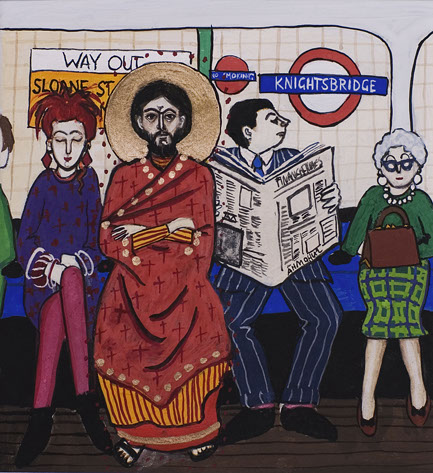So I've been musing on some of the reasons why we are able to regularly avoid artistic catastrophe, muddled music from within the "guitar army" camp and generally a positive and loving groove among both performances and our various audiences. Here is what comes to mind:
+ I am consciously committed to collaborating with God towards the creation of something beautiful, fun and for the common good. In Bruce Ellis Benson's small but wise volume, Liturgy as a Way of Life: Embodying the Arts in Christian Worship, he writes, "If beauty originates from God, then all beauty found in the world is reflected beauty." There is, you see, a clear connection between the Greek word for being called (kalien) and our ability to recognize something as beautiful (kalon.) Indeed, "what makes somethings beautiful is precisely that they call out to us... We call (some things) beautiful precisely because they call us and recall us... (for) the call is what constitutes the beautiful rather than the other way around... God's call precedes the pronouncement of beauty." (p. 36)
 What we do, therefore, is more improvisation with God's calling for "unlike God - who creates ex nihilo - we create as improvisers" working with making something new out of something that already exists. And what I want to playfully improvise is something that sounds - and looks - beautiful. Not something cruel or ugly or mean-spirited. And certainly not something that sounds muddled, ill-formed or cheap. That means that our sharing must be well practiced and carefully critiqued. Last week, for example, after our last "dress rehearsal" on Tuesday, it was clear that some songs had not come together in a presentable way. You could feel it - they created tension among the musicians rather than joy - so I had to cut them. Maybe if we had a few more weeks to work on them they would be ready for prime time, but not 5 days before the show. So, like Tom Skerritt's character in the movie, A River Runs Through It, after spending about 5 hours mapping and remapping the arc of the show, I handed our revised set-list back to the band saying, "Good job, but we have to cut in by a third, so let's try again."
What we do, therefore, is more improvisation with God's calling for "unlike God - who creates ex nihilo - we create as improvisers" working with making something new out of something that already exists. And what I want to playfully improvise is something that sounds - and looks - beautiful. Not something cruel or ugly or mean-spirited. And certainly not something that sounds muddled, ill-formed or cheap. That means that our sharing must be well practiced and carefully critiqued. Last week, for example, after our last "dress rehearsal" on Tuesday, it was clear that some songs had not come together in a presentable way. You could feel it - they created tension among the musicians rather than joy - so I had to cut them. Maybe if we had a few more weeks to work on them they would be ready for prime time, but not 5 days before the show. So, like Tom Skerritt's character in the movie, A River Runs Through It, after spending about 5 hours mapping and remapping the arc of the show, I handed our revised set-list back to the band saying, "Good job, but we have to cut in by a third, so let's try again." And let me be clear about three of the implications even in this: a) rehearsal is essential for improvising with beauty; b) artistic vision is not something that can be done by majority rule or playing to the lowest common denominator; and c) somebody has to be in charge. Without time for practice as a group, harmonies cannot be heard or nourished or polished. Without practice, the placement of musicians is left to chance - and that is often a total disaster - because if things don't feel right, they will inhibit how we make music. In our first set-up, I was buried in the back corner and unable to visually communicate with all the artists. I was also hemmed in by rows of microphones and amplifiers so that I couldn't physically check in or cue our players - and this created an unspoken but palpable anxiety.
So, midweek, after consulting with my two keenest musical allies, we reset the stage and revamped the play list because we were called by beauty to make it right - and it worked. It took an additonal four hours last Wednesday simply to move and test out the new placements of every performer, but once you hear the call of beauty it demands you pay attention. I had folk come early on Sunday, too to review the new set-up, test out their new placement and rework the sound checks. And even during the 90 minute performance, I needed to cue and re-cue folk - asking some to back off playing at times or change their volume level - and be a roving rock and roll Leonard Bernstien re: intensity, engagement with the audience, going a capella, hand-claps and all the rest. As one other veteran said after the gig, "Thank you for being so carefully in charge - it let the rest of us relax - and let the artists do what they do best."
+ The second theme has to do with fun: our shows have to be fun for both those making the music and those who come to listen. And if either side is not having fun, we have failed to improvise with the blessings and beauty God has provided. Now here's the thing: I can't have fun as a musician or band leader if my mates don't know the music. If they are stumbling or afraid, there is no joy. Neither can I have fun if I've asked some musicians to do more than they can deliver. With our young players, for example, it is essential to find ways for them to shine without dumbing down the whole show. They have to feel good about what they bring to the stage and know they have made a sweet contribution. This isn't a dog and pony or circus side-show: we are all sharing our gifts in pursuit of God's beauty.
Same goes for everyone else: if we're doing something really tough - and we did - people need time, focus, careful practice and the space to offer their best. Pick up bands can be fun, but they rarely stumble upon beauty. In working on Crosby, Stills, Nash and Young's "Carry On" we gave hours and hours to the middle a capella 8 bars that create a bridge between the "wooden" part of the song and the "electric" closing riffs. Same was true for our reworking of Herbie Hancock's arrangement of "Don't Give Up." In rehearsal there were weeks when we could not find a way to bring that song together not matter how hard we tried. But we kept at it and over the course of a month we learned not only the intricate rhythms but also the best way to let our multiple vocalists shine and soar. Some people like to think this can happen accidentally or causally - and that may be true from time to time - but not as a rule.
Now one of the ways I like to be playful in pursuit of fun is to juxtapose genres that fit thematically but only in the most intuitive sense. Yesterday, we opened with a Celtic/Appalachian hymn - "The Cool of the Day" - before slamming like a cymbal crash into Coldplay's "Clocks" (which the band played better than ever before and sang Dianne's hymn arrangement like angels, too.) The key to this fitting, however, was not only the modulation from Fm to Eb but also the resolution of the hymn's lament with Coldplay's conclusion: you... are! and nothing else compares! To my mind, the ancient could be fused with the contemporary because one helped answer the questions posed by the other: am I part of the cure or am I part of the disease?
Same happened by singing Chuck Berry's sultry, lazy shuffle, "Around and Around" in the prim and proper atmosphere of our Sanctuary. Getting loose and funky let people relax in a setting that might seem too formal for your average environmentalist so we worked to bring a "road house" groove to our Edwardian architecture. Bringing together artists with vastly different styles - and youth with adults - also creates a genre-bending ambiance in the best sense. And when everyone is able to sing in harmony together... it is both the embodiment of Christ's banquet AND an aural parable of the kingdom.
+ And third it must be for the common good, yes? It has only been in the last few years that "art" has been defined and shaped by the Romantic notion that we are creating purely for self-expression. To be sure, a lot of contemporary artists work under that misunderstanding - and often their creations are just about themselves - with no reference to the wider community. But as a person of faith I know that I have been called "NOT to conform to the ways of this world, but rather by the mercies of God to present my very body to God as living sacrifice... that I might be transformed by the renewing of my mind (and heart, soul and body, too.)" (Romans 12: 1-2) And every time we pull together a concert for the common good - for Katrina relief, for emergency fuel assistance in the Berkshires, for the Berkshire Environmental Action Team - artists sense that our venue will be a safe, respectful and creative place to share their gifts. They are liberated to play for the common good - for a higher calling - with allies.
Again, Benson is helpful when he writes:
What is so problematic about modern or romantic conceptions of the arts? One immediate problem is that central to these conceptions is the demand that art and artist be freed from the usual expectations of responsibility to the community. Further, following Immanuel Kant, we tend to envision the art is as "genius," someone who creates in an inexplicable way (think, for example, of Mozart in the film Amadeus) ... Kant was likewise influential in claiming that art does not express truth but merely emotion - and we tend to think that making art is largely about "expressing yourself." Tragically, the fact that much art has come to be seen as marginal in people's lives is the result not of the modern theory of art's having lost the day but of its having won it. For, if art communicates no truth and is merely about expressing one's feelings (apart for the common good) then why should anyone care about it. It would seem like a frivolous luxury, which is exactly what many people think about art.
For me there is a theological, practical and aesthetic grounding for my work as band leader, pastor and artist: I am lifted up - and God is praised - when very different people are able to tap into their sacred gifts in pursuit of beauty, fun and the common good. It gives us all a vision for what is possible in a way that is playful, cooperative, disciplined and joy-filled. In this we are living just as God intended - and what a gas!
credits:
1) Kandinsky, Improvisaton 1 @ www.wassilykandinsky.net
2) Kandinsky, Flood Improvisation @ www.wikipaintings.org
3) Kandinsky, Improvisation 12 @ www.wpclipart.com
4) Kandinsky, Improvisation 7 @ www.terminartors.com



.png)




No comments:
Post a Comment